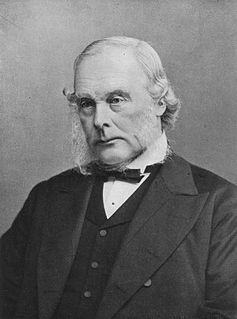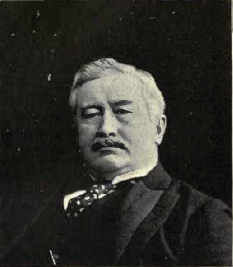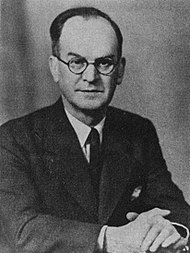
Joseph Lister, 1st Baron Lister, was a British surgeon and a pioneer of antiseptic surgery. From a technical viewpoint, Lord Lister was not an exceptional surgeon, but his research into bacteriology and infection in wounds raised his operative technique to a new plane where his observations, deductions and practices revolutionised surgery throughout the world.

Surgery is a medical or dental specialty that uses operative manual and instrumental techniques on a person to investigate or treat a pathological condition such as a disease or injury, to help improve bodily function, appearance, or to repair unwanted ruptured areas.

Cardiothoracic surgery is the field of medicine involved in surgical treatment of organs inside the thoracic cavity — generally treatment of conditions of the heart, lungs, and other pleural or mediastinal structures.
An abdominoperineal resection, formally known as abdominoperineal resection of the rectum and abdominoperineal excision of the rectum is a surgery for rectal cancer or anal cancer. It is frequently abbreviated as AP resection, APR and APER.
Henry Clay Dalton was superintendent of the St. Louis City Hospital, Missouri, United States, from 1886 to 1892, and later a professor of abdominal and clinical surgery at Marion Sims College of Medicine. He is noted for being the first American to perform the suturing of the pericardium on record. Spanish surgeon Francisco Romero was documented with performing two successful surgeries in 1801 and French surgeon Dominique Jean Larrey was documented as successfully performing surgery on a woman's pericardium in 1810.

Sir John Eric Erichsen, 1st Baronet was a Danish-born British surgeon.

Thoracoscopy is a medical procedure involving internal examination, biopsy and/or resection/drainage of disease or masses within the pleural cavity, usually with video assistance. Thoracoscopy may be performed either under general anaesthesia or under sedation with local anaesthetic.

Sir Alexander Ogston MD CM LLD was a British surgeon, famous for his discovery of Staphylococcus.

Sir Thomas George Roddick was a Canadian surgeon, medical administrator, politician, and founder of the Medical Council of Canada born in Harbour Grace, Newfoundland

Edoardo Bassini was an Italian surgeon born in Pavia.
An exploratory laparotomy is a general surgical operation where the abdomen is opened and the abdominal organs are examined for injury or disease. It is the standard of care in various blunt and penetrating trauma situations in which there may be life-threatening internal injuries. It is also used in certain diagnostic situations, in which the operation is undertaken in search of a unifying cause for multiple signs and symptoms of disease, and in the staging of some cancers.
Various individuals have advanced the surgical art and, as a result, have been called the father of surgery by various sources.

Arvind Kumar is the Chairman, Institute of Chest Surgery, Chest Onco Surgery and Lung Transplantation at Medanta Hospital, Gurugram and Founder & Managing Trustee, Lung Care Foundation. He is Former Chairman, Center for Chest Surgery and Director, Institute of Robotic Surgery at Sir Ganga Ram Hospital (SGRH) New Delhi. He is Former Professor of Surgery & Head of Thoracic & Robotic Surgery Unit, All India Institute of Medical Sciences (AIIMS), New Delhi (1988-2012). He was President of the Association of Surgeons of India in 2019.

Sir Clement Price Thomas was a pioneering Welsh thoracic surgeon most famous for his 1951 operation on King George VI.

George Hogarth Pringle was a Scottish-Australian surgeon. He qualified in medicine from Edinburgh, Scotland and then worked in the Royal Infirmary of Edinburgh along with the young Joseph Lister with whom he continued to correspond. He settled in Parramatta, New South Wales, Australia and is credited with introducing Listerian antisepsis into Australia.

Sir Charles Bent Ball, 1st Baronet, Hon FRCS MD FRCSI was an Irish surgeon and an honorary surgeon to the King in Ireland.
David John Sugarbaker was an American physician who was Chief of the Division of General Thoracic Surgery and the Director of the Baylor College of Medicine Lung Institute at CHI St. Luke's Health–Baylor St. Luke's Medical Center in Houston, Texas. He was an internationally recognized thoracic surgeon specializing in the treatment of mesothelioma, the surgical management of malignant pleural mesothelioma, and treatment of complex thoracic cancers.

Arthur Tudor Edwards was a Welsh thoracic surgeon, who worked at the Westminster Hospital, the Royal Brompton Hospital and Queen Mary's Hospital, Roehampton and pioneered lung surgery in particularly pulmonary tuberculosis and lung tumours.
John Rutherford Ryley was an Irish-born surgeon who studied medicine in Glasgow, where he learned about Listerian antisepsis from Joseph Lister. He emigrated to New Zealand and introduced antiseptic surgery there in January 1868. Most of his career was then spent in Australia. He took his own life at the age of 46.

Sir Thomas Frederick Chavasse, MD, FRCSEd, FRCSEng was an English surgeon, who learned the practice of antiseptic surgery from Joseph Lister in Edinburgh and remained an exponent of this technique throughout his career. As a surgeon at the Birmingham General Hospital he was influential in the design of the new hospital in 1897 and was an active fundraiser for the project. An active supporter of the British Red Cross Society and the St John's Ambulance Brigade, he was knighted in 1905.














